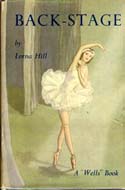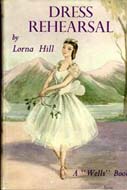Dancing Across the Border: An Adult Reading of Lorna Hill
 Dedicated to LH – past and present.
Dedicated to LH – past and present.
To the casual observer, the fourteen Sadler’s Wells and six Dancing Peel stories written by Lorna Hill may be imagined to be only of interest to balletomanes. Those who refuse to judge a book by its cover will soon realize that the decorative dust jackets showing dancers in classical poses disguise a text in which ballet forms only the surface layer, a background on which to overlay the larger themes of life, love and art. In this first of four articles I will look at how ballet is depicted in these two series, how it is one of four main strands running through the twenty titles, all of which contrast and entwine to form a complex and literary body of work.
When we enter the world of Lorna Hill we do not find ourselves in a fairytale land where cherubic infants spend idyllic lives in perpetual sunshine. What we find are real people in the real world, and so it is with ballet, which despite being shown as undeniably romantic, is never romanticized. The dancing schools we visit are populated by those who see dancing as the only way to escape poverty and a life selling cauliflowers at the co-op, the precocious brats who delight their mothers with displays of tap and ballroom, the tough cookies who lack artistic integrity but have the ambition and technique to succeed, and the truly talented who may spend their career in the corps without that lucky break. In short, all human life is here; the ballet class is a vibrant microcosm.
Anyone who has stood at the barre practising endless plié, relevé and tendu will know just how much hard work it takes to become a professional dancer, the breathless exhaustion behind the effortless facade. Lorna Hill unflinchingly portrays the stark reality behind the glamour, the hours spent in practise and rehearsal taking harsh criticism from temperamental ballet masters, the sacrifice of a social life when spare time is spent washing tights and darning shoes. To reach the top requires the almost impossible combination of physical perfection, a strong constitution, an expressive face, intelligence and sensitivity, a vivid imagination and innate musicality – all of which will count for nothing without the good fortune of being in the right place at the right time. It is no wonder that the successful few, like Annette Dancy, dedicate their entire life to dancing; only in class or on stage do they truly come alive.
This all enveloping passion for ballet is reflected in how many of the characters dress, off stage they are happy to wear any old thing, not caring in the least how they look in their everyday clothes. But when it comes to an item of dancewear, nothing is given greater care or attention, mending a favourite pair of tights or lovingly ironing each delicate frill of a tutu. These are the practise clothes of a bygone age, when girls as well as boys wore jock-belts, the tunic being the predecessor of the now ubiquitous leotard and the ever so practical catsuit – in fact leotards are only mentioned in the last two Dancing Peel books. In this pre-Lycra world, nylon tights are an unaffordable luxury and great ingenuity is needed to raise enough cash to buy the fabric that will become a beautiful ballet dress. Another privileged glimpse into the real world of the dancer is the use of methylated spirits and shellac to re-block pointe shoes, a method still widely used today.
Lorna Hill cleverly underlines this realism by seamlessly combining fact and fiction. A performance at Covent Garden may feature Fonteyn and Elvin alongside Weston and Rosetti, the fictional ballerinas being so plausible that I expect to see a photograph of Veronica Weston or a review of the Cosmopolitan Ballet Company’s latest tour as I turn the pages of my Ballet Annuals from the nineteen fifties – that one can suspend belief to such an extent is a tribute to the authors skill.
 It must be remembered that these books were first published in an era of mass popularity for ballet, when principal dancers enjoyed the status of film stars. An amusing divertissement in Dancing Peel illustrates this perfectly: Miss Brandon’s school echoes to ‘The Blaydon Races’ and ‘The Keel Row’ as the decorators set to work – one of them recognizes a photograph of Moira Shearer and demonstrates an arabesque to his pals with brush and paint pot still in hand! The very existence of these two series is partially due to a social climate in which ballet, for the first and arguably only time, was widely enjoyed by the working classes – it is highly unlikely that such books would be produced today.
It must be remembered that these books were first published in an era of mass popularity for ballet, when principal dancers enjoyed the status of film stars. An amusing divertissement in Dancing Peel illustrates this perfectly: Miss Brandon’s school echoes to ‘The Blaydon Races’ and ‘The Keel Row’ as the decorators set to work – one of them recognizes a photograph of Moira Shearer and demonstrates an arabesque to his pals with brush and paint pot still in hand! The very existence of these two series is partially due to a social climate in which ballet, for the first and arguably only time, was widely enjoyed by the working classes – it is highly unlikely that such books would be produced today.
Grasping the significance of setting ballet within the landscape of Northumberland is fundamental to an understanding of Lorna Hill’s work. Vicki Scott says of dancing ‘For one thing it doesn’t last. You do it – and that’s the end of it.’ Compare this to Jon Craymore saying of Northumberland ‘There’s something age old and unchanging about this landscape.’ Two deceptively simple sentences that encapsulate the very essence of the novel’s submerged existence, the pivotal motif that haunts all twenty books, this contrast of the fleeting art and the ancient county provides a fascinating dichotomy, a spark of genius to ignite the reader’s imagination.
Although the outward incompatibility of rural Northumberland and the sophisticated world of dance is spoken of, for many of the principal characters must leave their remote homes to pursue their dreams in London, a deeper and more profound link forms another essential aspect of the series. A Dream of Sadler’s Wells contains the important scene, much revisited in later titles, of young  Veronica Weston dancing the waltz from Les Sylphides outside Sebastian’s cottage window. Despite being barefoot and wearing only a cheap cotton frock, her dancing is enriched by being in its appropriate woodland setting. In the early Sadler’s Wells books are a number of sublime passages where Veronica is inspired by thoughts of woods, hills, flowers and streams as she dances; proving that contrary to being out of place in Northumberland, ballet is very much at home in a pastoral environment. Classical ballet technique is based upon nature and Lorna Hill points out the similarity to the turned out position of the Highland reel, another style of dancing that reflects the natural splendour of its native setting.
Veronica Weston dancing the waltz from Les Sylphides outside Sebastian’s cottage window. Despite being barefoot and wearing only a cheap cotton frock, her dancing is enriched by being in its appropriate woodland setting. In the early Sadler’s Wells books are a number of sublime passages where Veronica is inspired by thoughts of woods, hills, flowers and streams as she dances; proving that contrary to being out of place in Northumberland, ballet is very much at home in a pastoral environment. Classical ballet technique is based upon nature and Lorna Hill points out the similarity to the turned out position of the Highland reel, another style of dancing that reflects the natural splendour of its native setting.
To read these books is to be transported back to the ballet classes of our youth, smooth pink or black tights cover nicely turned out legs, well broken-in shoes that are more comfortable than aesthetic, posture checked by a glance in the unforgiving mirror. A thrill of anticipation as the music is about to begin, soon we will enter an enchanted world away from the mundane…and one and two and three and four…
Copyright Frederick Lewis 2005

Christine on Sun, 21st Nov 2010 10:21 am
What a lovely article. I am a great fan of Lorna Hill, especially her Marjorie and Patience books. Your article was particularly informative as you paint the background of the Ballet stories, the era in which they were published. In a way, this has helped my understanding of the series. Certainly her characters always seem real and it is hard not to search for them!
Anne Marie on Wed, 31st Aug 2011 4:52 pm
I have just found this page and enjoyed reading it. I have re-collected all the books bar: Dancer on Holiday and Vicki in Venice. I just cannot justify spending the 70 odd and the hundred pounds or so buying these. I wish there were a way of just reading them, as I have never even read them. I really love the horseriding and camping books particularly the one on Lindisfarne and the NE coast. I don\’t suppose anyone has those two missing books for me to read?
shin on Wed, 16th Jan 2013 10:04 pm
wow, thank you for this article and your insights.
I LOVED her book the Dancing Peel (I only read the rest of the series a lot later on in life and somehow, didn’t have that ooomph factor for me anymore sad) – it’s just so bloody romantic – the setting of Northumbria, and the all-consuming effort dedicated to their art.
Hazel Gorley on Thu, 28th Jul 2016 12:33 am
I am planning a trip to England soon, and am hoping to see the house where Lorna Hill lived. I seem to recall “Brocklehurst” near Keswick. Does anyone have any idea if this is correct?
GeorgeBernstein blog on Fri, 15th Dec 2017 2:48 pm
Hmm it seems like your blog ate my first comment (it was super long) so
I guess I’ll jus sum it up what I had written andd
say, I’m thoroughly enjoying your blog. I
ttoo am an aspiring blog blogger bbut I’m still new to the whole thing.
Do you have any helpful hints for novice blog writers? I’d really appreciate
it.
Serena Smith on Mon, 18th Dec 2017 11:40 pm
A lovely article, thank you.
I was a keen amateur ballet dancer when I discovered Lorna Hill’s books in my local library.
As well as informing my understanding of ballet beyond the barre of my provincial ballet classes, Lorna Hill inspired in me a life long love of Northumberland, the Scottish Isles and their history and people. I loved the way characters from the ballet books appear in other series – it was like unexpectedly meeting old friends. I owe many lovely holidays and relationships to Lorna Hill and those beautiful books.
Agnita Oyawale on Sat, 6th Jan 2018 2:26 pm
I read the first 8 of the Sadlers wells series as a child and have reread them over the years. My mother raised me on her own so could not affordthe cost of ballet lessons.
I would love to read Lorna Hill’s other books.
I enjoyed reading the article. Thank you.
Isobel Campbell on Tue, 10th Nov 2020 10:33 am
I read A Dream of Sadlers Wells when I was little, and hadn’t thought about it since, until I googled it today when a memory of it came back to me out of nowhere. This lovely and interesting article really resonated and reminded me of all the things that originally made the books appeal to me so much. I am so glad that I found it. Thank you.